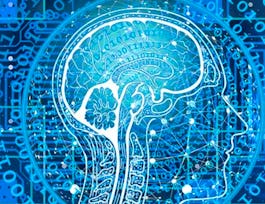This course introduces you to one of the main types of modeling families of supervised Machine Learning: Classification. You will learn how to train predictive models to classify categorical outcomes and how to use error metrics to compare across different models. The hands-on section of this course focuses on using best practices for classification, including train and test splits, and handling data sets with unbalanced classes.


Supervised Machine Learning: Classification
This course is part of multiple programs.
Taught in English
Some content may not be translated



Instructors: Mark J Grover
27,452 already enrolled
Included with 
Course
(311 reviews)
95%
Skills you'll gain
Details to know

Add to your LinkedIn profile
22 quizzes
Course
(311 reviews)
95%
See how employees at top companies are mastering in-demand skills

Build your subject-matter expertise
- Learn new concepts from industry experts
- Gain a foundational understanding of a subject or tool
- Develop job-relevant skills with hands-on projects
- Earn a shareable career certificate


Earn a career certificate
Add this credential to your LinkedIn profile, resume, or CV
Share it on social media and in your performance review

There are 6 modules in this course
Logistic regression is one of the most studied and widely used classification algorithms, probably due to its popularity in regulated industries and financial settings. Although more modern classifiers might likely output models with higher accuracy, logistic regressions are great baseline models due to their high interpretability and parametric nature. This module will walk you through extending a linear regression example into a logistic regression, as well as the most common error metrics that you might want to use to compare several classifiers and select that best suits your business problem.
What's included
12 videos4 readings3 quizzes2 app items
K Nearest Neighbors is a popular classification method because they are easy computation and easy to interpret. This module walks you through the theory behind k nearest neighbors as well as a demo for you to practice building k nearest neighbors models with sklearn.
What's included
8 videos1 reading3 quizzes2 app items
This module will walk you through the main idea of how support vector machines construct hyperplanes to map your data into regions that concentrate a majority of data points of a certain class. Although support vector machines are widely used for regression, outlier detection, and classification, this module will focus on the latter.
What's included
12 videos1 reading4 quizzes2 app items
Decision tree methods are a common baseline model for classification tasks due to their visual appeal and high interpretability. This module walks you through the theory behind decision trees and a few hands-on examples of building decision tree models for classification. You will realize the main pros and cons of these techniques. This background will be useful when you are presented with decision tree ensembles in the next module.
What's included
9 videos2 readings3 quizzes2 app items
Ensemble models are a very popular technique as they can assist your models be more resistant to outliers and have better chances at generalizing with future data. They also gained popularity after several ensembles helped people win prediction competitions. Recently, stochastic gradient boosting became a go-to candidate model for many data scientists. This model walks you through the theory behind ensemble models and popular tree-based ensembles.
What's included
15 videos3 readings6 quizzes7 app items
Some classification models are better suited than others to outliers, low occurrence of a class, or rare events. The most common methods to add robustness to a classifier are related to stratified sampling to re-balance the training data. This module will walk you through both stratified sampling methods and more novel approaches to model data sets with unbalanced classes.
What's included
10 videos1 reading3 quizzes1 peer review2 app items
Instructors



Offered by
Recommended if you're interested in Machine Learning
Why people choose Coursera for their career




Learner reviews
Showing 3 of 311
311 reviews
- 5 stars
85.53%
- 4 stars
11.25%
- 3 stars
0.64%
- 2 stars
0.96%
- 1 star
1.60%
New to Machine Learning? Start here.

Open new doors with Coursera Plus
Unlimited access to 7,000+ world-class courses, hands-on projects, and job-ready certificate programs - all included in your subscription
Advance your career with an online degree
Earn a degree from world-class universities - 100% online
Join over 3,400 global companies that choose Coursera for Business
Upskill your employees to excel in the digital economy
Frequently asked questions
Access to lectures and assignments depends on your type of enrollment. If you take a course in audit mode, you will be able to see most course materials for free. To access graded assignments and to earn a Certificate, you will need to purchase the Certificate experience, during or after your audit. If you don't see the audit option:
The course may not offer an audit option. You can try a Free Trial instead, or apply for Financial Aid.
The course may offer 'Full Course, No Certificate' instead. This option lets you see all course materials, submit required assessments, and get a final grade. This also means that you will not be able to purchase a Certificate experience.
When you enroll in the course, you get access to all of the courses in the Certificate, and you earn a certificate when you complete the work. Your electronic Certificate will be added to your Accomplishments page - from there, you can print your Certificate or add it to your LinkedIn profile. If you only want to read and view the course content, you can audit the course for free.
If you subscribed, you get a 7-day free trial during which you can cancel at no penalty. After that, we don’t give refunds, but you can cancel your subscription at any time. See our full refund policy.






